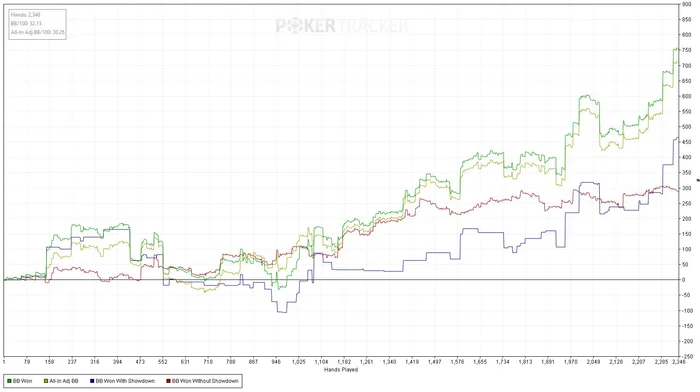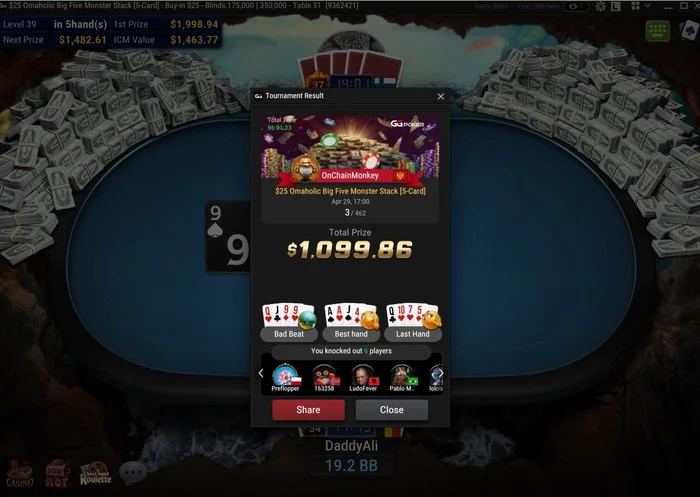Margot's Diary
-
PopularityTop-2
-
posts7
-
Impressions8,422
-
Subscriptions1
-
Author's karma0
-
-
Hi! Great.
How are you?
-
FullHouse99, Hi Fullhouse99, I am great,
today I got message from my student that he crash his limit well, always happy so see good result from my students:

and you, how are you today FullHouse99?
-
Margot, Hello hello! Very nice graph you have here :)
-
MattC, It's not mine.
It's graphic of my student.
He asked about Stefan Burakov training in 'censored'
but school mainly work on Russian languages, watched by myself about 50 hours from there, pretty interesting to watch over genious on his study.
so I asked to my student main questions about poker by myself and make with him few trainings,
after that he sent me this graphic, looks pretty good,
proud of him,
always pleasure to see good graph.
Red line concept is main if you want to win from bots and RTA players
If you want I could help to you either : No Limit Holdem, Omaha5 or any other game, even in chess such principle work better,
my chess trainer for example was winner of USSR chess tournament and either win it cause of agressive style, it has a lot of advantage about 'calculators' style of players,
you need to move about zero or low ev figure from lowest line of matrix to more higher to make extra pressure on your opponent weaknesses, less time players need to act more such low figures you could gambit,
cause bluffs shouldn't show much or any +EV, but in fact they show because of many reasons, - and this allow you to extract extra equity from betting, raising
-
Tried omahaholic omaha5 tournament 2.5 Bucks and and took first place, after that tried other series
In the more expensive tournaments, “only” third place =)
, make one mistake understimate my opp in one moment. Interesting tourney — turns out that was my “third bullet.” So overall, out of four tournaments: one first place, one in the money, one lost (with two entries), and now third place on the third entry
Looks like I’ll have to keep playing this series
Well, at least I earned enough to fix a tooth
of my real life avatar,
Omaha5 on omahaholic on gg networek is pretty new game for those who like to think by their own brains, and strategy is pretty simple

-
https://youtu.be/1g37waDdpuM?si=2aRGDDRu_hdfmxpe&t=188
On 3:08 with AhTh5sAd9c I wanna check this kind of hand or make little smaller from 1/3 to 3/4. What make us to bet bank here on turn?
here we see 62/40 opponent his range looks like (48!10%)
with little slowplays after flop, some Q5, Q3, 33, some 88 with hh, Khh, 6342, 6457 types of hands,
I mean if he jam that we would 'call on chances' but if we check to catch river
or bet-call by smaller bet we could induce more value with our hand again a lot of dominated hand, that would chraise with smaller or bet versus our check,
or donk in H, hmmmm ideal situation is if we could induce his call to donk in our h outs, - so I wanna keep his 6342, 6457, Khh, Qhh, hands so maybe 1/3-3/4 that looks like 'last block semivalue with weak AA' or even check to bluffcatch againsts dominated hands
with AhTh5sAd9c against 48!10%:(Q5,Q3,33,88hh,Khh,Qhh,6342, 6457) on 3sQh5h8c our hand have 41.159% equity
isnt? Where am I wrong?😅
if we look on similar claster, ouh this coinpoker I have some hands from there, on my fishy statistic on legrande 27 hands 50/35 he have 83% bet river 5/6 O_o,
so yeah against this snowflake I guess it's better to check or bet smaller to bluffcatch with more comfort against this looks to wide opponent -
Today we’re going to break down a spot involving paired boards in 5-card Omaha.
For example, various situations come up. Let’s say we’re on the button, holding a hand like two queens on a Q-7-7 board. We bet, he calls. We bet the turn, he calls again. River is a 9. We bet, and he shoves. So the question is: does the opponent almost always have quads in this spot?To put it simply – yes, it really looks like it.
If you check the stats for river raises out of position on paired boards, they’re only around 2.8%. That already suggests a very tight range.If we take the general fold rates to barreling on these kinds of textures, we see that out-of-position players fold a lot:
On paired boards: flop folds ~63%, 52%, 46%, 42%, 35% depending on sizing
Turn folds: 60%, 50%, 42%, 32%
River folds: 70% to a pot-sized bet, 58% to ¾ pot, 35% to ½ pot, and just 20% to ⅕ pot.
Basically, people don’t fold when facing small bets on the river.
If we assume that the opponent continues through flop and turn 0.58% each time (which is roughly how much of their range they’re continuing with), and we multiply those, we get around 0.33% of hands making it to the river. And that’s pretty much just quads. So if we divide 1 by 33 (to get the inverse), we land at around 2.8%, which matches the raise rate. Again – this means almost always quads.But it’s not always that simple – there are different types of opponents.
Here we’re analyzing an aggregate pool report, likely just regular players – a sample of about 1 million hands against opponents with VPIP from 20 to 45, PFR from 15 to 25, and at least 100 hands played.Of course, if you're up against someone with stats like 50/30, heads-up, or in a dynamic environment, things may change. But in general, for standard fields:
Let’s look at quads distribution by paired board ranks:
Paired deuces: quads = 0.22%
Threes: 0.27%
Fours: 0.35%
Fives: 0.47%
Sixes: 0.71%
Eights: ~1%
Nines: 0.97%
Tens: 1.36%
Jacks: 1.66%
Queens: 1.8%
Kings: 1.93%
Aces: 2.15%
The higher the rank of the paired card, the more quads are possible.
By the time we reach the river (after turn/fold filters), the number of quads triples, making up 3–6% of hands depending on the board.Many players don’t donk their quads – even though GTO suggests they should sometimes.
Especially in some pools (like GG Poker with jackpots from 88s), players may never donk their strong hands. They only check-raise or shove the river – but almost never donk flop or turn.Let’s look at specific boards.
Say we have J-J without a 5, on a J-5-5 board. This hand still shows good equity, but largely because the solver includes some donk with quads. Hands like 99 might also go all-in here.Let’s consider a Q-9-9 board, and we hold QQ. Some 99 combos are donked on flop and river (e.g., about half the time on river). If we have QQ, it’s a very thin value bet, or might even be a fold, depending on blockers. Even Q9 may be indifferent. You need specific blockers (like a 3) to make calling profitable.
And when we look at likely bluffs from the BB, we see that they’re very rare.
A proper bluff (say, KQTT, QQJx, etc.) would have to:Float the flop, despite 40–50% fold rates
Continue on the turn, again with high fold tendencies
Then bluff the river with a large polar sizing (pot or ¾ pot)
Most people just don’t reach that point, so their river raises are almost always value-heavy.
Again:
Higher paired cards → more quads
Very few natural bluffs
You can literally multiply fold percentages to estimate how little of villain’s range reaches the river (e.g., 34% flop fold, 34% turn fold = only 0.33 of the original range makes it to river)
So if river raise stats show 2.8% raise, and quads make up almost all of that, we can be pretty confident: this is not a bluff
There are, of course, exceptions – some players might be overbluffing (you’ll see 20% river raise frequency), and then you have to adjust.
But in general, you need to be very cautious when calling river raises with hands that are only slightly better than trips, especially in static board textures, polar sizings, and no strong dynamic.
For example, a hand like TT on an 8-8-x board, if you face a check-raise shove on the river, you might want to just fold – or consider prior different strategies.
Funny, even the solver doesn’t jam quads, like on Q-9-9, because it sees no value – no worse hands to extract value from.
So, all in all:
The higher the pair on board, the more likely villain has quads
Bluffs are rare
If someone raises river, assume it’s strong unless you have a good reason to believe otherwise
Adjust your sizings or lines accordingly
Think about blockers, donk frequencies, and opponent tendencies
That’s it!
If you enjoyed it, like, subscribe, and share. Next time, we’ll look at the same types of spots but in 3-bet pots. Thanks for watching. Take care!
- You will be able to leave comments, rate posts, participate in discussions and increase your poker level.
- If you prefer a four-colour deck or want to turn off avatar animation, change your profile settings.
- You will have an access to bookmarks, staking and other useful poker tools.
- On each page you will see where new posts and comments have appeared.
- If you are registered in poker rooms through GipsyTeam, you will receive rake statistics, bonus points for in-store purchases, exclusive promotions and extended support.
Hello Gipsy Team world!
My name is Petr. I am glad to see you!
How are you today?